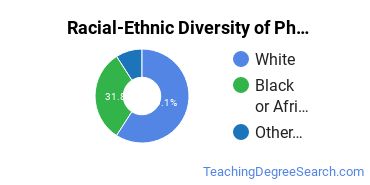Physical Education Teaching & Coaching at Jacksonville State University
Jacksonville State University is located in Jacksonville, Alabama and approximately 9,238 students attend the school each year.
Want to know more about the career opportunities in this field? Check out the Careers in Physical Education Teaching & Coaching section at the bottom of this page.
Jacksonville State University Physical Education Teaching & Coaching Degrees Available
- Bachelor’s Degree in Physical Education Teaching
- Master’s Degree in Physical Education Teaching
Jacksonville State University Physical Education Teaching & Coaching Rankings
The physical education teaching major at Jacksonville State University is not ranked on College Factual’s Best Colleges and Universities for Physical Education Teaching & Coaching. This could be for a number of reasons, such as not having enough data on the major or school to make an accurate assessment of its quality.
Physical Education Teaching Student Demographics at Jacksonville State University
Take a look at the following statistics related to the make-up of the physical education teaching majors at Jacksonville State University.
Jacksonville State University Physical Education Teaching & Coaching Bachelor’s Program

About 63% of those who receive a bachelor's degree in physical education teaching at Jacksonville State University are white. This is typical for this degree on the nationwide level. Prospective students may be interested in knowing that this school graduates 4% more racial-ethnic minorities in its physical education teaching bachelor's program than the national average.*
The following table and chart show the race/ethnicity for students who recently graduated from Jacksonville State University with a bachelor's in physical education teaching.

| Race/Ethnicity | Number of Students |
|---|---|
| Asian | 0 |
| Black or African American | 6 |
| Hispanic or Latino | 0 |
| White | 12 |
| International Students | 0 |
| Other Races/Ethnicities | 1 |
Jacksonville State University Physical Education Teaching & Coaching Master’s Program

Of the students who received a physical education teaching master's degree from Jacksonville State University, 52% were white. This is below average for this degree on the natiowide level. In the physical education teaching master's program at this school, racial-ethnic minorities make up 48% of degree recipients. That is 16% better than the national average.*
The following table and chart show the race/ethnicity for students who recently graduated from Jacksonville State University with a master's in physical education teaching.

| Race/Ethnicity | Number of Students |
|---|---|
| Asian | 0 |
| Black or African American | 11 |
| Hispanic or Latino | 1 |
| White | 14 |
| International Students | 0 |
| Other Races/Ethnicities | 1 |
Related Majors
Careers That Physical Education Teaching Grads May Go Into
A degree in physical education teaching can lead to the following careers. Since job numbers and average salaries can vary by geographic location, we have only included the numbers for AL, the home state for Jacksonville State University.
| Occupation | Jobs in AL | Average Salary in AL |
|---|---|---|
| High School Teachers | 16,270 | $51,180 |
| Middle School Teachers | 10,010 | $50,210 |
| Fitness Trainers and Aerobics Instructors | 2,800 | $34,660 |
| Coaches and Scouts | 2,420 | $44,030 |
| Education Professors | 880 | $72,430 |
References
*The racial-ethnic minorities count is calculated by taking the total number of students and subtracting white students, international students, and students whose race/ethnicity was unknown. This number is then divided by the total number of students at the school to obtain the racial-ethnic minorities percentage.
- College Factual
- National Center for Education Statistics
- O*NET Online
- Image Credit: By Thomson200 under License
More about our data sources and methodologies.
